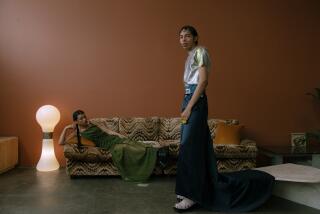HOME DECORATION : Mobiles Breeze Back From the ‘60s
- Share via
Alexander Calder and Fisher-Price made a name for themselves in decorative mobiles that have endured for museums and nurseries, but a couple of other makers want to restore mobiles to the popularity they enjoyed in the 1950s and 1960s.
Joel Hotchkiss started making mobiles when he was art director at a Boston ad agency. In 1979, he quit his job and moved to San Francisco. A shop in Ghirardelli Square specialized in mobiles, and the owner took his samples on consignment and gave him work space.
Today, Hotchkiss works in Oakland. With the help of his wife and three employees, he turns out one-of-a-kind designs and about 20 production models in copper, brass, aluminum, sailcloth and monofilament thread. They’re sold through art galleries and museum shops. Prices range from $47 to $1,300, but most sales are in the $100 to $350 range.
His mobiles, like Calder’s, are abstract. They range from about 12 inches across to 8-by-5 feet high. They are most at home in contemporary settings.
Many of the mobiles at Swe-Den Inc. in Madison, Conn., are based on Scandinavian folk craft. In Denmark and Germany, lore is that a mobile stops moving if someone who wishes you ill goes near it, says Elizabeth Morch, who with her husband, Hans, opened Swe-Den in 1983. Prices for Swe-Den mobiles range from $1.50 to $295.
Mobiles are important in Denmark today as house gifts and year-round and holiday decoration. Hans Morch credits Christian Flensted, a Dane who began making mobiles in 1954, with reviving the tradition.
How mobiles made the transition from folk talisman to modern art icon is anybody’s guess. But they caught the fancy of modern artists, especially Calder, who is closely identified with the mobile as an art form.
Greg Clifton, a member of the painting and sculpture department at the Museum of Modern Art in New York, says it is part of the modern art tradition to take objects of everyday life and turn them into objects that are larger than life.
The museum owns about 20 Calder mobiles and generally has a couple--”Spider” and “Snowflake”--on display. The gift shop also sells mobiles, as do other museums such as the Guggenheim in New York and the Boston Museum of Science.
In home or office, mobiles can personalize a space either with a color used elsewhere in the room or with a design that says something about you, says Morch, who has more than a dozen hanging in his home.
“Asking where to put a mobile is like asking where to put a painting,” Hotchkiss says. “There are many suitable places, especially near ceilings, over a group of plants, in an archway, or anywhere that someone walking or standing won’t bump into it.”
One of the most popular spots is over a crib or changing table where an infant can be visually entertained by bright color and movement. Just be sure he can see but not touch.
Some nursery mobiles incorporate a music box or night light or can be ordered with bedding to match, according to Deborah Albert of the Juvenile Products Manufacturers Assn. in Marlton, N.J.
Although most mobiles are very light in weight, they should be hung securely. Keep them away from drafts, fans and air-conditioner vents because their movement can be disconcerting if it’s more than a gentle sway.
In addition to mobiles for museum and home, there’s an entire genre for the workplace. Some from Swe-Den that hang on a theme include a chef, mother-to-be and no-smoking sign.
“The expectant mothers sell extremely well to gynecologists and midwives,” Morch says.
Another winner for the doctor’s office is the no-smoking mobile. A red heart with the word “please” dangles from a gray cloud that says “no smoking.” The background of the cloud is a printed list of the carcinogens in cigarettes.
More to Read
The biggest entertainment stories
Get our big stories about Hollywood, film, television, music, arts, culture and more right in your inbox as soon as they publish.
You may occasionally receive promotional content from the Los Angeles Times.









